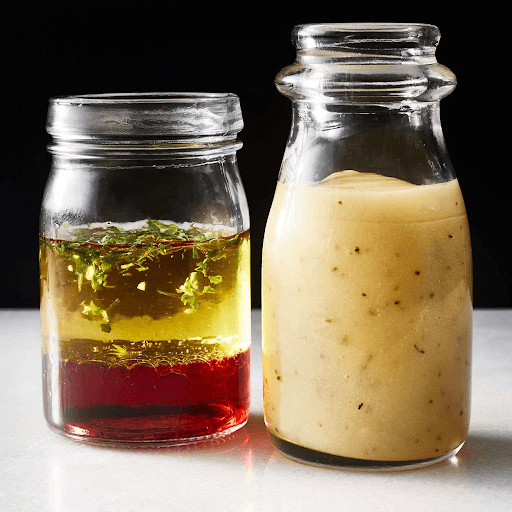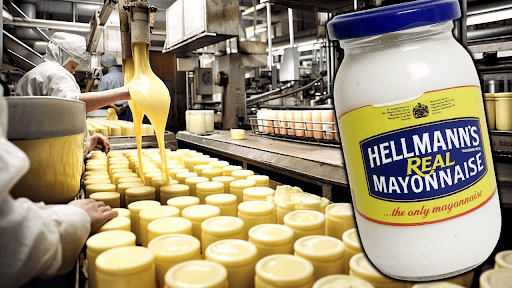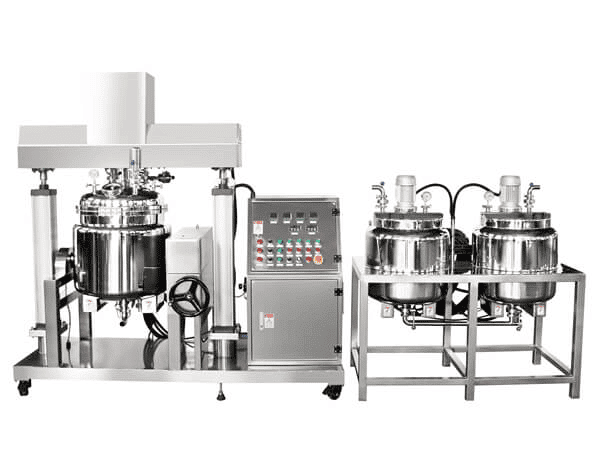Curious about how is mayonnaise made in factories? Get the latest insights on the mayonnaise manufacturing process, including all the mixing equipment & machines used!
Did you know that the creamy mayonnaise you spread on your sandwiches has a fascinating production process behind it? Let’s delve into how factories craft this beloved condiment, blending simple ingredients into something truly delicious.
Key Takeaways
- Mayonnaise is a complex oil-in-water emulsion primarily consisting of vegetable oil, egg yolks, and vinegar or lemon juice.
- The manufacturing process involves crucial steps like emulsification, pasteurization, and precise ingredient blending.
- Advanced machinery, including high-shear mixers and emulsifiers, are key to achieving the perfect consistency and quality of mayonnaise.
Ingredients in Mayonnaise

In every jar of mayonnaise, the magic starts with its core ingredients: vegetable oil, egg yolks, and an acidic component like vinegar or lemon juice. Each plays a pivotal role in creating that smooth, rich taste we all love.
| Ingredient | Common Percentage in Mayonnaise | Role in Mayonnaise |
| Vegetable Oil | 65% – 80% | Primary base; provides texture and flavor. Soybean oil is frequently used due to its neutral flavor. |
| Egg Yolks | 4% – 8% | Act as natural emulsifiers due to lecithin content. They help in stabilizing the emulsion of oil and water. |
| Water | 5% – 15% | Adjusts consistency and acts as a medium for dissolving some ingredients. |
| Vinegar/Lemon Juice | Variable | Adds tanginess and lowers pH for preservation. Different types are used (like white or cider vinegar) for varied flavors. |
| Spices & Seasonings | Variable | Includes salt, sugar, and mustard. Enhances flavor; mustard also acts as an emulsifier. Other herbs and spices might be added based on regional or recipe-specific variations. |
| Additives | Variable | Includes thickeners (like modified food starches in low-fat variants), preservatives (like calcium disodium EDTA), and additional emulsifiers and stabilizers for texture and shelf-life. |
- Vegetable Oil: The primary ingredient in mayonnaise, typically making up more than 65% to 80% of the product, is vegetable oil. The choice of oil can vary, but soybean oil is commonly used due to its neutral flavor and cost-effectiveness. Other oils like canola or maize oil might also be used, balancing cost with desired taste and texture profiles.
- Egg Yolks: Egg yolks are crucial for their emulsifying properties. They contain lecithin, a natural emulsifier, which helps blend oil and water to create a stable emulsion. In commercial production, the yolk is often used in different forms – either as fresh, pasteurized liquid or in powdered form. The egg content must be carefully balanced; too little can result in a weak emulsion, while too much can overpower other flavors.
- Vinegar or Lemon Juice: The acidic components, such as vinegar or lemon juice, add a tangy flavor and help stabilize the emulsion. They also contribute to the preservation of mayonnaise by lowering its pH. Different types of vinegar, like white or cider vinegar, can be used, each imparting a unique flavor profile. Lemon or lime juice, diluted with water, is also a popular choice, especially in variations seeking a fresher, more citrusy taste.
- Water: Water is often added to adjust the consistency of mayonnaise. In commercial production, it’s crucial to control the water content to maintain the desired viscosity and shelf stability.
- Spices and Seasonings: To enhance flavor, a variety of spices and seasonings can be added to mayonnaise. Common additions include salt, sugar, and mustard. Mustard not only adds flavor but also serves as an additional emulsifier. Other seasonings like herbs and spices can be added according to taste preferences and regional variations.
- Additives for Stability and Flavor: To achieve the desired consistency and shelf-life, various additives are incorporated. These might include thickeners like modified food starches, especially in low-fat versions where they help mimic the texture provided by egg yolks and oil. Preservatives like calcium disodium EDTA are added to increase shelf-life. Some recipes also include additional emulsifiers and stabilizers to ensure consistency in texture.
- Alternative Ingredients for Special Varieties: In response to dietary preferences and restrictions, manufacturers also produce variations of mayonnaise. For example, in some cultures, there’s a demand for eggless mayonnaise, which omits egg yolks and often includes alternative emulsifying agents.
The Role of Emulsifiers in Mayonnaise

Egg yolks aren’t just for richness; they’re natural emulsifiers. This means they help oil and water, which normally don’t mix, come together in a harmonious emulsion, giving mayonnaise its stable, creamy texture.
The Mayonnaise Manufacturing Process

Now, let’s take a peek into the step-by-step journey of mayonnaise from raw ingredients to the final product. It’s a meticulous process ensuring every jar meets the high standards of taste and quality.
1. Preparation of Ingredients
The journey begins with the preparation of the core ingredients: vegetable oil, egg yolks, and an acidic component (vinegar or lemon juice). In commercial settings, the egg yolks may be used in liquid form or as a powder, and the oil is usually a neutral type like soybean oil.
2. Mixing and Emulsification
The heart of mayonnaise manufacturing lies in the emulsification process. This stage involves the gradual mixing of oil into a blend of egg yolks and water. High-shear mixers are employed to ensure a smooth and uniform emulsion. The process requires precise control of the oil flow to avoid breaking the emulsion.
3. Adding Flavors and Seasonings
After the basic emulsion is formed, seasonings such as salt, sugar, and mustard are added. The mustard not only enhances flavor but also helps stabilize the emulsion further.
4. Pasteurization for Safety
To ensure product safety and extend shelf life, the mayonnaise is pasteurized. This involves heating the mixture to a specific temperature to kill any harmful bacteria, without cooking the eggs.
5. Achieving Desired Consistency
The viscosity of mayonnaise is a critical quality parameter. Depending on the desired consistency, water and thickeners (like modified food starch in low-fat versions) are added. This step is crucial for achieving the right texture and mouthfeel.
6. Quality Control Testing
Each batch of mayonnaise undergoes rigorous testing. Parameters like pH, viscosity, and flavor are checked against strict standards to ensure consistency and quality.
7. Packaging
Once the mayonnaise passes all quality checks, it is moved to the bottling or packaging station. Here, it’s filled into jars, bottles, or sachets, sealed, and labeled for distribution.
8. Storage and Distribution
The final products are then stored in a controlled environment until they are distributed to retail locations or directly to consumers.
Advanced Equipment in Mayonnaise Production
Manufacturing mayonnaise isn’t just about the ingredients; it’s also about the technology. High-shear mixers and emulsifiers are the unsung heroes, ensuring each batch is consistent in texture and quality.
List of Equipment in Mayonnaise Production
The manufacturing of mayonnaise is a complex process that requires precision and consistency. To achieve this, modern factories utilize a range of advanced equipment.
Each piece of machinery plays a vital role in ensuring the quality and efficiency of production.
1. High-Shear Mixers

High-shear mixers, like the Ginhong High Shear Mixers, are central to the mayonnaise production process. These mixers are designed to efficiently blend the oil and egg yolk mixture, ensuring a stable and uniform emulsion. They operate at high speeds, creating the necessary shear force to disperse the oil droplets evenly throughout the emulsion.
2. Emulsifiers and Homogenizers

Equipment like the Ginhong Vacuum Emulsifier Homogenizers are crucial in achieving the desired consistency and texture of mayonnaise. These machines further refine the emulsion, reducing the size of oil droplets to create a smoother and thicker product. The Z Emulsifier is particularly noted for its ability to customize up to three stages of rotor-stator tooling, catering to different types of mayonnaise production needs.
3. Pasteurization Systems
Pasteurization is essential for extending the shelf life and ensuring the safety of mayonnaise. The process involves heating the product to a specific temperature to eliminate harmful bacteria.
Advanced pasteurization systems are designed to handle this task efficiently without compromising the quality of the mayonnaise.
4. Filling and Bottling Equipment
Once the mayonnaise is prepared, it needs to be packaged for distribution. This is where filling and bottling equipment come into play. These machines precisely measure and dispense the right amount of mayonnaise into jars, bottles, or other containers. They ensure that packaging is done efficiently and hygienically, maintaining the product’s integrity.
5. Quality Control Instruments
To ensure that each batch of mayonnaise meets the set standards, quality control instruments are used. These might include pH meters, viscosity testers, and other analytical devices. They provide accurate measurements that help maintain consistency across all batches of mayonnaise produced.
6. Cooling and Storage Systems
After production, mayonnaise needs to be stored correctly before distribution. Cooling and storage systems are employed to maintain the optimal temperature, preserving the quality of the mayonnaise until it reaches the consumer.
Ginhong’s Advanced Range of Mixing Equipment for your Mayonnaise Production
Ginhong’s range of industrial mixers, including vacuum emulsifier homogenizers, high shear mixers, multi-shaft mixers, and planetary mixers, play a crucial role in achieving the perfect consistency and texture in mayonnaise production.
The mayonnaise manufacturing industry encounters several challenges, from ensuring uniform emulsion in large-scale batches to maintaining the stability and texture of the final product.
Ginhong’s mixers adeptly address these challenges, offering solutions that streamline the manufacturing process while upholding the quality of mayonnaise. A key tool in this process is the Ginhong High Shear mixer, which operates in several stages:
- Initial Mixing: The process begins by adding the base liquid, typically water, into the vessel, followed by activation of the mixer. The egg yolks, which act as emulsifiers, are then introduced and swiftly dispersed within the rotor/stator workhead.
- Intensive Shearing: As the ingredients are driven by centrifugal force toward the outer part of the workhead, they undergo intense shearing in the narrow gap between the rotor and the stator. This intense action ensures that the oil, dispersed in fine droplets, blends uniformly into the mix, creating a stable emulsion.
- Continuous Blending: The mixer consistently draws new material into the workhead. In an efficient cycle, the ingredients pass repeatedly through the workhead, ensuring a smooth and homogenous blend. This stage is vital for achieving the creamy and consistent texture that is characteristic of high-quality mayonnaise.
Conclusion
From a blend of simple ingredients to a staple in kitchens worldwide, mayonnaise production is a fine example of culinary science and engineering. Next time you enjoy this creamy condiment, remember the intricate process behind its creation.
FAQs
1. What makes mayonnaise so creamy?
It’s all about the emulsification process, where oil and egg yolks are blended to perfection.
2. Can mayonnaise be made without eggs?
Yes, there are eggless varieties catering to different dietary needs.
3. What role does technology play in mayonnaise production?
Advanced mixers and emulsifiers ensure consistent texture and quality in every batch.

